Generation Mining reports on Biiwobik Prospect drilling and summer surface exploration results
Drills 10 metres of 0.97 g/t Pd and 0.59% Cu near surface
Toronto, Ontario – November 8, 2021 – Generation Mining Limited (TSX: GENM; OTCQB: GENMF) (“Gen Mining” or the “Company”) is pleased to announce results from the remaining eight holes drilled this summer in the Chonolith and Powerline zones at the Biiwobik Prospect, situated immediately north of the Marathon palladium-copper deposit in Northwestern Ontario. The Biiwobik Prospect name originates from the Biigtigong Nishnaabeg’s First Nation dialect of the Nishnaabe language meaning “metal”.
The Company also reports on the results of summer prospecting, mapping, and trenching activities carried out along the northeast margin of the Coldwell Complex between the Redstone and Four Dams prospects, including detailed work immediately east of the Sally Deposit encompassing the Willie Zone and the Boyer Prospect (see location map included as Figure 1, all figures are included at the end of this news release).
The Company completed a positive feasibility study (see March 3rd, 2021 news release) which contemplates the development of an open-pit mining operation with robust project economics over a 13-year mine-life. As with recently completed work on the Central Feeder Zone (see 2021 news releases of January 25th, May 10th and August 17th) current exploration activities are focused on evaluating the potential for additional resources which could, in the future, potentially extend the life of the proposed operation.
Biiwobik Prospect Drilling
Results from GenMining’s initial drill program at the Biiwobik Prospect are very encouraging. The near surface Powerline Zone has Pd and Cu grades that are similar to the Main Zone of the Marathon Deposit the northern extremity of which is situated approximately 300 m to the south. Drill density in this part of the property is low and surface exploration limited. With additional drilling and detailed surface sampling, there is excellent potential to define open-pit accessible resources at the Biiwobik Prospect.
Jamie Levy, Gen Mining’s CEO, stated “We are excited by these results as there is the potential to develop additional resources near the Marathon Deposit”.
Results from the first three holes drilled this year in the Powerline and Chonolith zones were reported in the Company’s September 2nd, 2021, news release. Assay results for an additional eight holes are provided below in Table 1.
Drill density is such that the true width of drill intercepts is estimated to be about 75% of the length of the drill core sampled. Results are consistent with earlier drilling in this area. With reference to Table 1, broad intervals, herein defined as composited drill intercepts of >10 m, range up to 72 m of 1.01 g/t PdEq in the deeper Chonolith Zone in hole MB 21-46. In terms of grade the best broad interval intercept was in hole MB 21-52 which intersected 1.96 g/t PdEq over 10m in the near surface Powerline Zone.
Drill hole collars and the location of vertical sections 5406450N and 5406650N are shown in Figure 2. Vertical sections 5406450N and 5406650N are shown in figures 3 and 4, respectively.
The Biiwobik Prospect comprises two discrete mineralized zones which are hosted by Marathon Series rocks that are primarily Two Duck Lake gabbro. The upper zone, referred to as the Power Line Zone, comprises a near surface intrusion controlled by a footwall embayment (a thermally eroded channel) like the structural setting of the Main Zone of the Marathon deposit. The lower zone referred to as the Chonolith Zone appears to be a channelized chonolith structure (a magma tube) within the Archean footwall.
Table 1 – Significant Assay Results Holes MB 21-46 to MB 21-53, inclusive.
|
Hole |
From |
To |
Length* |
Zone** |
Pd (g/t) |
Pt (g/t) |
Au (g/t) |
Ag (g/t) |
Cu (%) |
PdEq (g/t)*** |
Min. |
|
|---|---|---|---|---|---|---|---|---|---|---|---|---|
|
MB-21-46 |
87 |
99 |
12 |
PL |
1.06 |
0.22 |
0.09 |
0.53 |
0.13 |
1.43 |
Oxide |
|
|
And |
268 |
340 |
72 |
CH |
0.54 |
0.12 |
0.05 |
1.23 |
0.27 |
1.01 |
Main |
|
|
Incl. |
298 |
308 |
10 |
CH |
0.91 |
0.20 |
0.06 |
1.78 |
0.40 |
1.60 |
Main |
|
|
|
||||||||||||
|
MB-21-47 |
80 |
94 |
14 |
PL |
0.82 |
0.19 |
0.08 |
0.31 |
0.06 |
1.08 |
Oxide |
|
|
And |
154 |
172 |
18 |
PL |
0.52 |
0.14 |
0.08 |
1.90 |
0.23 |
0.98 |
Footwall |
|
|
And |
361 |
364 |
3 |
CH |
1.61 |
0.37 |
0.19 |
3.37 |
0.49 |
2.64 |
Footwall |
|
|
And |
369 |
372 |
3 |
CH |
0.83 |
0.30 |
0.10 |
2.67 |
0.37 |
1.58 |
Footwall |
|
|
|
||||||||||||
|
MB-21-48 |
121 |
127 |
6 |
PL |
1.32 |
0.30 |
0.09 |
0.47 |
0.13 |
1.74 |
Oxide |
|
|
And |
261 |
303 |
42 |
CH |
0.47 |
0.16 |
0.05 |
0.89 |
0.17 |
0.84 |
Footwall |
|
|
And |
309 |
329 |
20 |
CH |
0.61 |
0.23 |
0.05 |
0.97 |
0.18 |
1.03 |
Footwall |
|
|
Incl. |
313 |
315 |
2 |
CH |
2.16 |
0.81 |
0.15 |
1.40 |
0.28 |
3.12 |
Footwall |
|
|
And |
335 |
371 |
36 |
CH |
0.52 |
0.13 |
0.06 |
1.02 |
0.22 |
0.93 |
Main |
|
|
|
||||||||||||
|
MB-21-49 |
77 |
97 |
20 |
PL |
0.27 |
0.07 |
0.03 |
0.22 |
0.06 |
0.41 |
Main |
|
|
And |
289 |
298 |
9 |
CH |
0.22 |
0.05 |
0.04 |
1.00 |
0.13 |
0.45 |
Main |
|
|
And |
306 |
310 |
4 |
CH |
1.86 |
0.45 |
0.30 |
6.60 |
0.68 |
3.23 |
Footwall |
|
|
|
||||||||||||
|
MB-21-50 |
|
No Significant Intercepts |
||||||||||
|
|
||||||||||||
|
MB-21-51 |
4.1 |
14 |
9.9 |
PL |
0.31 |
0.15 |
0.16 |
0.94 |
0.20 |
0.79 |
Oxide |
|
|
And |
37 |
47 |
10 |
PL |
0.73 |
0.19 |
0.13 |
0.92 |
0.19 |
1.20 |
Main |
|
|
Incl. |
43 |
47 |
4 |
PL |
1.27 |
0.30 |
0.23 |
1.50 |
0.31 |
2.04 |
Main |
|
|
And |
71 |
75 |
4 |
PL |
0.82 |
0.27 |
0.08 |
0.25 |
0.05 |
1.10 |
Oxide |
|
|
And |
187 |
201 |
14 |
CH |
0.25 |
0.06 |
0.02 |
0.44 |
0.08 |
0.41 |
Footwall |
|
|
And |
219 |
223 |
4 |
CH |
0.70 |
0.20 |
0.05 |
0.95 |
0.17 |
1.09 |
Main |
|
|
And |
261 |
269 |
8 |
CH |
0.51 |
0.31 |
0.03 |
0.25 |
0.05 |
0.77 |
W-Style |
|
|
|
||||||||||||
|
MB-21-52 |
24 |
64 |
40 |
PL |
0.55 |
0.10 |
0.07 |
1.42 |
0.30 |
1.07 |
Main |
|
|
Incl. |
40 |
50 |
10 |
PL |
0.97 |
0.17 |
0.13 |
2.74 |
0.59 |
1.96 |
Main |
|
|
And |
70 |
78 |
8 |
PL |
0.61 |
0.13 |
0.07 |
0.55 |
0.09 |
0.87 |
Main |
|
|
And |
216 |
234 |
18 |
CH |
0.24 |
0.04 |
0.03 |
0.99 |
0.23 |
0.58 |
Main |
|
|
And |
256 |
340 |
84 |
CH |
0.55 |
0.16 |
0.06 |
1.29 |
0.27 |
1.06 |
Main |
|
|
Incl. |
266 |
294 |
28 |
CH |
0.88 |
0.22 |
0.08 |
2.04 |
0.45 |
1.67 |
Main |
|
|
|
||||||||||||
|
MB-21-53 |
11 |
47 |
36 |
PL |
0.29 |
0.06 |
0.06 |
1.13 |
0.24 |
0.69 |
Main |
|
|
And |
73 |
87 |
14 |
PL |
0.23 |
0.06 |
0.03 |
0.71 |
0.13 |
0.47 |
Main |
|
|
And |
161 |
169 |
8 |
PL |
0.34 |
0.07 |
0.04 |
1.28 |
0.23 |
0.73 |
Footwall |
|
|
And |
181 |
197 |
16 |
PL |
0.49 |
0.12 |
0.05 |
1.56 |
0.24 |
0.92 |
Footwall |
|
|
Incl. |
181 |
185 |
4 |
PL |
0.94 |
0.16 |
0.07 |
3.05 |
0.47 |
1.73 |
Footwall |
|
|
And |
239 |
265 |
26 |
CH |
0.91 |
0.20 |
0.08 |
1.92 |
0.38 |
1.61 |
Main |
|
|
Incl. |
247 |
253 |
6 |
CH |
1.23 |
0.29 |
0.11 |
2.50 |
0.51 |
2.16 |
Main |
|
|
Also Incl. |
257 |
259 |
2 |
CH |
2.18 |
0.35 |
0.21 |
2.50 |
0.51 |
3.22 |
Main |
|
* True width of intercept is approximately 75% of the length of the interval sampled
** PL corresponds to the Powerline Zone and CH refers to the Chonolith Zone
*** The Palladium Equivalent (“PdEq”) calculation expressed in g/t is the sum of the theoretical in situ value of the constituent metals (Au + Pt + Pd + Cu) divided by the value of one gram of palladium. The calculation makes no provision for expected metal recoveries or smelter payables. USD per ounce commodity prices of $1,725, $1,000, $1,400 were used, respectively, for Pd, Pt and Au and a $3.20/lb. value was assigned for Cu
Summer Surface Exploration
In addition to the drill program, a three-person surface exploration crew actively explored the area between the Redstone and the Four Dams prospects (see Figure 5). This area comprises a 14 km long portion of the Coldwell Complex margin, which includes the Sally Deposit and Boyer Prospect. The area has the potential to host ultramafic intrusions with high-grade mineralization. Previous drilling and surface sampling has returned extremely high-grade assays from apatite bearing pyroxenites which have assayed up to 2.59 g/t Au, 0.48 g/t Pt, 185 g/t Pd, 9.11% Cu and 0.60% Ni (see February 25th, 2020, news release).
A total of 95 personnel-days were devoted to surface mapping and prospecting. The bulk of the effort (73 days) was focused on prospecting the Willie Zone which is situated between the Sally Deposit and Boyer Prospect. Additionally, crews spent 31 days mapping and sampling three trenches at the Boyer Prospect. The most anomalous surface assays were obtained from the Willie Zone and assays results are compiled in Table 2 below:
Table 2 : Surface Samples of Two Duck Lake Gabbro – Willie Zone (>0.5 g/t PdEq*)
|
Sample |
Easting |
Northing |
Elev. |
Au (g/t) |
Pt (g/t) |
Pd (g/t) |
Cu (%) |
PdEq (g/t)* |
|---|---|---|---|---|---|---|---|---|
|
K004927 |
540038 |
5412223 |
363.22 |
0.17 |
0.36 |
1.55 |
0.388 |
2.37 |
|
K006361 |
539117 |
5412298 |
282.01 |
0.15 |
0.12 |
0.27 |
0.204 |
0.7 |
|
K006362 |
539103 |
5412303 |
288.44 |
0.08 |
0.11 |
0.2 |
0.267 |
0.67 |
|
K004597 |
539822 |
5412350 |
285.81 |
0.05 |
0.19 |
0.34 |
0.084 |
0.59 |
|
K004926 |
540046 |
5412219 |
365.55 |
0.06 |
0.13 |
0.35 |
0.048 |
0.52 |
*The Palladium Equivalent (“PdEq”) calculation expressed in g/t is the sum of the theoretical in situ value of the constituent metals (Au + Pt + Pd + Cu) divided by the value of one gram of palladium. The calculation makes no provision for expected metal recoveries or smelter payables. USD per ounce commodity prices of $1,725, $1,000, $1,400 were used, respectively, for Pd, Pt and Au and a $3.20/lb. value was assigned for Cu.
**Lithologies sampled are Marathon Series 2d coarse grained olivine gabbro and 3b coarse grained ophitic gabbro.
Prospecting at Willie was designed to follow up and expand historic showings east of the Sally Deposit. The Willie Zone is situated between the Sally Deposit and the Boyer Prospect and comprises a 300 m east- west oriented mineralized trend of Two Duck Lake gabbro along the eastern margin of Willie Lake and a 200 m southwest-northeast oriented mineralized lineament on the western margin of Willie Lake.
During mapping and sampling at Willie 167 grab samples were obtained; a list of significant assays (>0.5 g/t PdEq) are provided in Table 2. The best assay received was from a sample of Two Duck Lake gabbro (sample no. K004927) which assayed 1.55 g/t Pd and 0.39% Cu which is comparable to grades within the Marathon deposit situated approximately 15 km to the southeast.
At Boyer, three trenches opened in 2019, were mapped and sampled in 2021. The geology of the three trenches is dominantly brecciated Two Duck Lake gabbro comprising fine grained to pegmatitic varieties. Mineralization is largely hosted by associated pyroxenites. Trenching results are included in Table 3 below:
Table 3: Boyer - Trench Composite Sample Results
|
Trench # |
Samples |
Length (m)* |
Au (g/t) |
Pt (g/t) |
Pd (g/t) |
Cu (%) |
PdEq (g/t)** |
|---|---|---|---|---|---|---|---|
|
BYT-21-007 |
C372269 - C372281 |
11.33 |
0.06 |
0.2 |
0.52 |
0.046 |
0.74 |
|
Incl. |
C372271 - C372273 |
1.96 |
0.07 |
0.39 |
1.25 |
0.037 |
1.58 |
|
And |
C372288 - C372327 |
29.99 |
0.09 |
0.21 |
0.53 |
0.067 |
0.81 |
|
Incl. |
C372289 - C372292 |
1.97 |
0.21 |
0.4 |
1.25 |
0.186 |
1.9 |
|
Also incl. |
C372302 - C372303 |
1.23 |
0.2 |
0.45 |
1.27 |
0.114 |
1.1 |
|
Also incl. |
C372304 - C372318 |
8.86 |
0.14 |
0.34 |
0.93 |
0.093 |
1.36 |
|
|
|||||||
|
BYT-21-008 |
C372423 - C372465 |
28.1 |
0.09 |
0.15 |
0.24 |
0.097 |
0.64 |
|
Incl. |
C372439 - C372447 |
5.39 |
0.12 |
0.68 |
0.81 |
0.018 |
1.33 |
|
Incl. |
C372440 - C372440 |
0.71 |
0.42 |
1.29 |
1.84 |
0.031 |
2.96 |
|
|
|||||||
|
BYT-21-009 |
C372520 - C372548 |
20.81 |
0.11 |
0.28 |
0.38 |
0.17 |
0.71 |
|
Incl. |
C372529 - C372533 |
2.29 |
0.32 |
0.68 |
0.92 |
0.093 |
1.69 |
*Composites calculated using a lower cut-off of $13 NSR with up to 4 m internal dilution
**The Palladium Equivalent (“PdEq”) calculation expressed in g/t is the sum of the theoretical in situ value of the constituent metals (Au + Pt + Pd + Cu) divided by the value of one gram of palladium. The calculation makes no provision for expected metal recoveries or smelter payables. USD per ounce commodity prices of $1,725, $1,000, $1,400 were used, respectively, for Pd, Pt and Au and a $3.20/lb. value was assigned for Cu.
Trenching results have expanded the mineralized zone at Boyer to a 1.6 km strike length. The relatively low Cu/Pd ratio at Boyer suggests the Boyer Prospect has origins similar to the high-grade W-Horizon at the Marathon Deposit and consequently it remains an exploration area of interest going forward.
Quality Assurance/Quality Control
Quality assurance and quality control (“QA/QC”) protocols for the 2021 drilling assay program were unchanged from previous years and involve a rotating inclusion of one duplicate, blank, low-grade standard and high-grade standard every 15 samples. All controls are checked to be within a working limit of 2 standard deviations. Sample intervals are selected in 1 m or 2 m lengths dependent on the nature of the mineralized zone. The core samples are split on site using a diamond saw where half of the core is sent for analysis and the other half is securely stored on site for future reference. All samples are shipped to ALS in Thunder Bay for processing.
Qualified Person
Rod Thomas, P.Geo., Company Vice-President Exploration and a Director has reviewed and approved the scientific and technical information contained in this news release. Mr. Thomas is a Qualified Person for the purposes of National Instrument 43-101 Standards of Disclosure for Mineral Projects.
About the Company
Gen Mining’s focus is the development of the Marathon Project, a large undeveloped platinum group metal mineral deposit in Northwestern Ontario. The Company released the results of the Feasibility Study on March 3, 2021 and published the NI43-101 Technical Report dated March 25, 2021. The Marathon property covers a land package of approximately 22,000 hectares, or 220 square kilometres. Gen Mining currently owns an 82.6% interest in the Marathon Project, with the remaining interest owned by Sibanye-Stillwater.
The Feasibility Study estimated that at US$1725/oz palladium, and US$3.20/lb copper, Marathon’s Net Present Value (at 6% discount rate) is approximately C$1.07 billion with a payback of 2.3 years and an Internal Rate of Return of 30%. Up front capital costs were estimated at C$665 million. The mine would produce an estimated 245,000 palladium equivalent ounces per year over a 13-year mine life at an All-In Sustaining Cost of US$809 per palladium-equivalent ounce. For more information, please review the detailed Feasibility Study dated March 25, 2021, filed under the Company’s profile at SEDAR.com.
For further information please contact:
Jamie Levy
President and Chief Executive
Officer
(416) 640-2934
(416) 567-2440
[email protected]
Forward-Looking Information
This news release contains certain forward-looking information and forward-looking statements, as defined in applicable securities laws (collectively referred to herein as “forward-looking statements”). Forward-looking statements reflect current expectations or beliefs regarding future events or the Company’s future performance. All statements other than statements of historical fact are forward-looking statements. Often, but not always, forward-looking statements can be identified by the use of words such as “plans”, “expects”, “is expected”, “budget”, “scheduled”, “estimates”, “continues”, “forecasts”, “Projects”, “predicts”, “intends”, “anticipates”, “targets” or “believes”, or variations of, or the negatives of, such words and phrases or state that certain actions, events or results “may”, “could”, “would”, “should”, “might” or “will” be taken, occur or be achieved, including statements relating to further exploration or advancing the Marathon Project to bring it into production. All forward-looking statements, including those herein are qualified by this cautionary statement.
Although the Company believes that the expectations expressed in such statements are based on reasonable assumptions, such statements are not guarantees of future performance and actual results or developments may differ materially from those in the statements. There are certain factors that could cause actual results to differ materially from those in the forward-looking information. These include commodity price volatility, continued availability of capital and financing, uncertainties involved in interpreting geological data, increases in costs, environmental compliance and changes in environmental legislation and regulation, the Company’s relationships with First Nations communities, exploration successes, and general economic, market or business conditions, as well as those risk factors set out in the Company’s annual information form for the year ended December 31, 2020, and in the continuous disclosure documents filed by the Company on SEDAR at www.sedar.com. Readers are cautioned that the foregoing list of factors is not exhaustive of the factors that may affect forward-looking statements. Accordingly, readers should not place undue reliance on forward-looking statements. The forward-looking statements in this news release speak only as of the date of this news release or as of the date or dates specified in such statements.
Forward-looking statements are based on a number of assumptions which may prove to be incorrect, including, but not limited to, assumptions relating to: the availability of financing for the Company’s operations; operating and capital costs; results of operations; the mine development and production schedule and related costs; the supply and demand for, and the level and volatility of commodity prices; timing of the receipt of regulatory and governmental approvals for development Projects and other operations; the accuracy of Mineral Reserve and Mineral Resource Estimates, production estimates and capital and operating cost estimates; and general business and economic conditions.
Investors are cautioned that any such statements are not guarantees of future performance and actual results or developments may differ materially from those projected in the forward-looking information. For more information on the Company, investors are encouraged to review the Company’s public filings on SEDAR at www.sedar.com. The Company disclaims any intention or obligation to update or revise any forward- looking information, whether as a result of new information, future events or otherwise, other than as required by law.
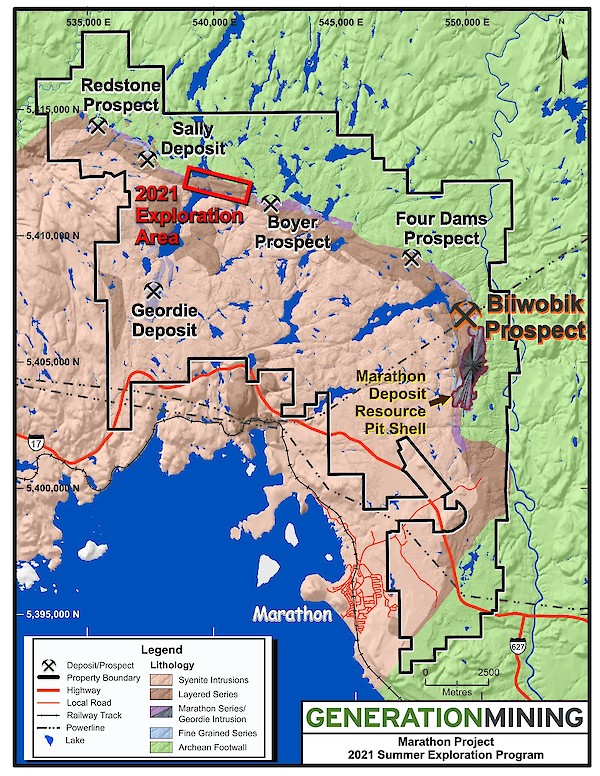
Figure 1: Property location map showing the location of the Biiwobik Prospect and the 2021 Exploration Area.
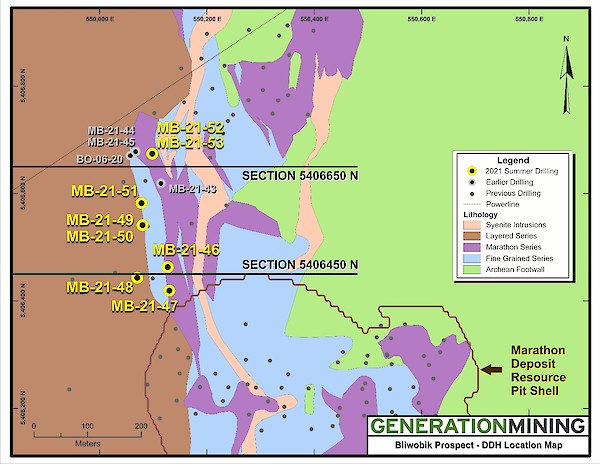
Figure 2: Drill collar location map showing the location of recently completed Gen Mining drill holes and the Benton Resources drill hole BO-06-20 which was drilled in 2006. Also shown are the locations of vertical cross sections 5406450N and 540650N.
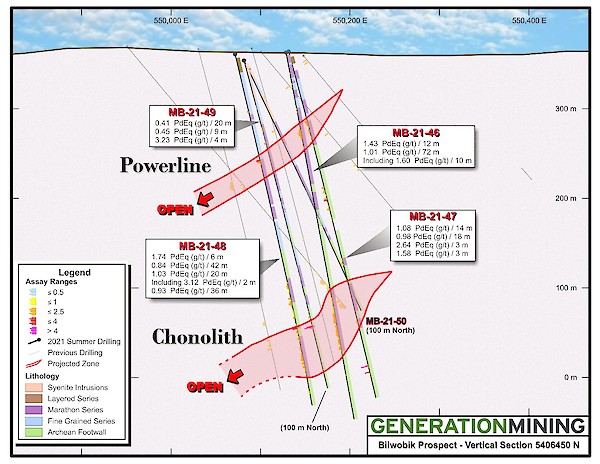
Figure 3: Vertical Cross Section 5406450N showing the disposition of the near surface Powerline and underlying Chonolith zones and results for Gen Mining drillholes MB 21-46 to MB 21-49, inclusive. The drill trace for MB 21-50 is also shown, however no significant mineralized intervals were encountered in hole MB 21-50.
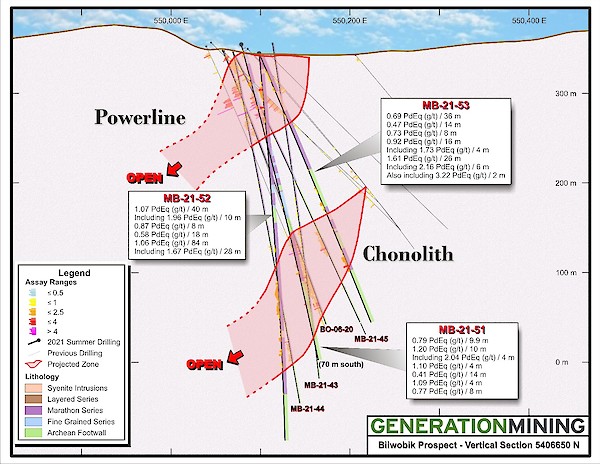
Figure 4: Vertical Cross Section 5406650N showing the disposition of the near surface Powerline and underlying Chonolith zones and results for Gen Mining drillholes MB 21-51 to MB 21-53, inclusive.
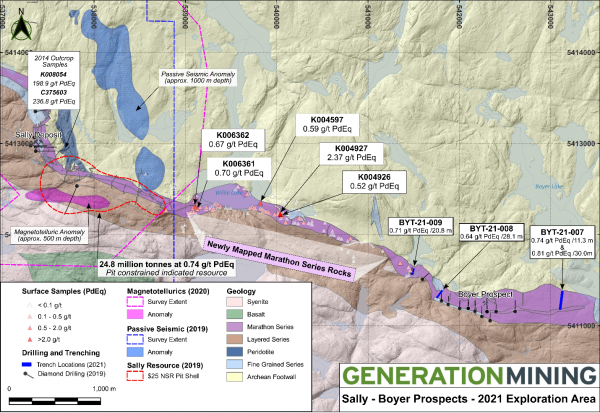
Figure 5: Geological compilation map of the 2021 Exploration Area encompassing the Sally Deposit and Boyer Prospect area. The Willie Zone is situated within the area of newly mapped Marathon Series rocks. Note the location of the Boyer trenches and the location of grab samples from the Willie Zone. The Sally deposit pit shell and possibly related magnetotelluric and passive seismic targets are situated just to the west of the Willie Zone.
